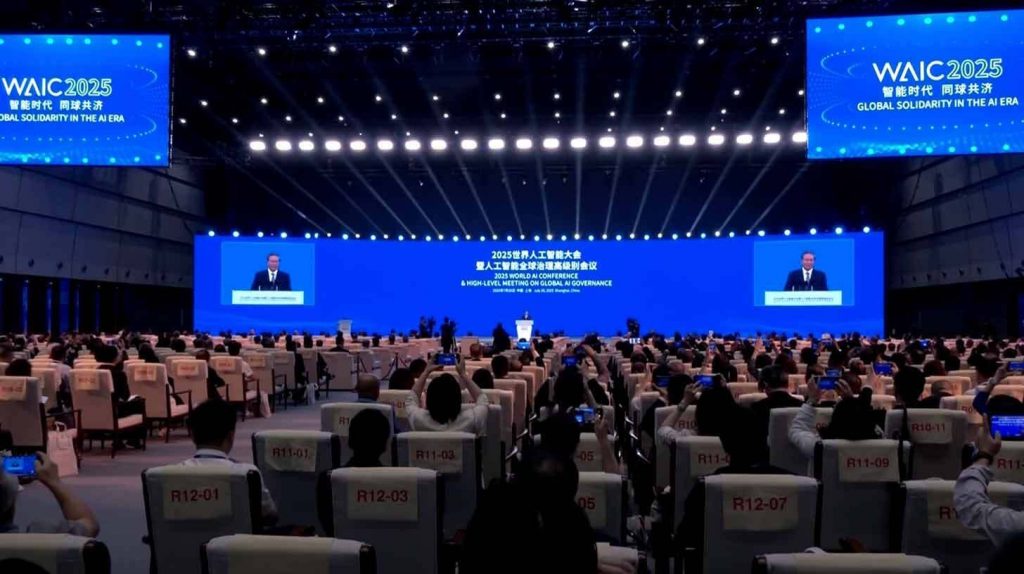China’s Counterpunch: As the AI arms race gains momentum, China has stepped into the ring not with a flex of dominance, but with an open hand extended toward cooperation. The release of its AI Action Plan during the 2025 World Artificial Intelligence Conference presents a sweeping alternative to the U.S.’s recently published strategy — one that challenges the zero-sum framing of technological leadership.

🌍 China’s Counterpunch AI Action Plan: Key Pillars
At its core, the plan positions artificial intelligence as a global public good, anchoring development around ethical innovation, inclusion, and infrastructure sharing. China’s strategy advocates a multilateral, open-source ecosystem backed by United Nations protocols, directly addressing concerns of AI monopolization.
“China is striking a very different tone than the U.S., with a much deeper focus on collaboration over dominance. By courting developing nations with an open approach, Beijing could provide an alternative “leader” in AI — offering those excluded from the more siloed Western strategy an alternative path to AI growth.” – The Rundown

🔑 Highlights from the Action Plan
- Global R&D and Infrastructure: Calls for joint labs, cross-border computing networks, and support for developing nations’ AI capabilities.
- Open Data and Source Collaboration: Encourages creation of international open-source platforms to share data, code, and standards.
- Governance Through Consensus: Supports frameworks like the UN’s Global Digital Compact, pushing for inclusive norms on AI ethics and safety.
- Environmental and Ethical Guardrails: Focuses on green AI development, algorithmic fairness, and regulatory harmonization via global bodies.
- Capacity Building: Proposes literacy programs and training specifically targeted at bridging the intelligence gap across regions — particularly for women, children, and the Global South.
🆚 The U.S. Position: Growth Through Deregulation
Released just days before, the U.S. AI Action Plan champions deregulation and private-sector dominance. The document frames the race for AI supremacy in stark terms: an urgent sprint toward global dominance. While it includes discussions around safety, ethics, and international partnerships, the tone leans heavily into national competitiveness and economic acceleration.

🥊 Global Counterpunch: A Strategic Contrast
While the U.S. approach echoes Cold War tech rivalries, China offers a counter-narrative: one of interdependence, shared prosperity, and UN-aligned governance. Premier Li Qiang’s remarks — that AI should not become an “exclusive game” — directly challenge what some see as a Western tendency toward technological gatekeeping.
This ideological divergence could have lasting impact:
- Developing Nations may find Beijing’s open-source and capacity-building framework far more accessible than the privatized pathways being pursued by U.S.-led coalitions.
- Regulators worldwide are now weighing which vision aligns more closely with local priorities — ethical integration vs. economic power.
- Tech Companies and NGOs may be drawn toward the transparency and interoperability proposed under China’s plan, particularly given its support for global data-sharing mechanisms and low-barrier participation models.

🐿️ The Final Nut: Decoding the Collision
China’s Action Plan is not just policy—it’s geopolitical choreography. It reframes AI as a tool for soft power, not just sovereign superiority. By seeding infrastructure into emerging regions and codifying openness as a value, Beijing sets itself up as a steward rather than a competitor. The implications go beyond technology: this is narrative architecture for a rebalanced digital future.
If the U.S. aims to win the AI race through acceleration, China appears to be playing chess — offering inclusion, ecosystem-building, and a future-proof governance framework designed to scale globally. The question isn’t just who leads, but how leadership is defined.
Please feel free to leave any comments or Contact Us with any questions.
🔗 Curated Source List
- Full Action Plan by China’s Ministry of Foreign Affairs English PDF
- UN Global Digital Compact Overview
- Premier Li Qiang’s WAIC 2025 Speech Highlights
- U.S. AI Strategy Overview – White House OSTP
- MIT Tech Review: AI Governance Divide Deepens
- Geoffrey Hinton’s WAIC Commentary – Ethics, Environment, and Governance
- The $6B Fusion Pivot: The Trump Media–TAE Merger (and the Internet Rumors It Accidentally Ignited)
- DOE’s Genesis Mission: The Federal AI Grid Behind the Collaboration Hype
- Stanford’s AI Experts Predict 2026: From Evangelism to Evaluation
- “Trump’s U.S. Tech Force-Innovation or Bureaucracy in Disguise?”
- Drone Swarms, AI, and the March Toward Automated Control: A Warning for Humanity


Leave a Reply